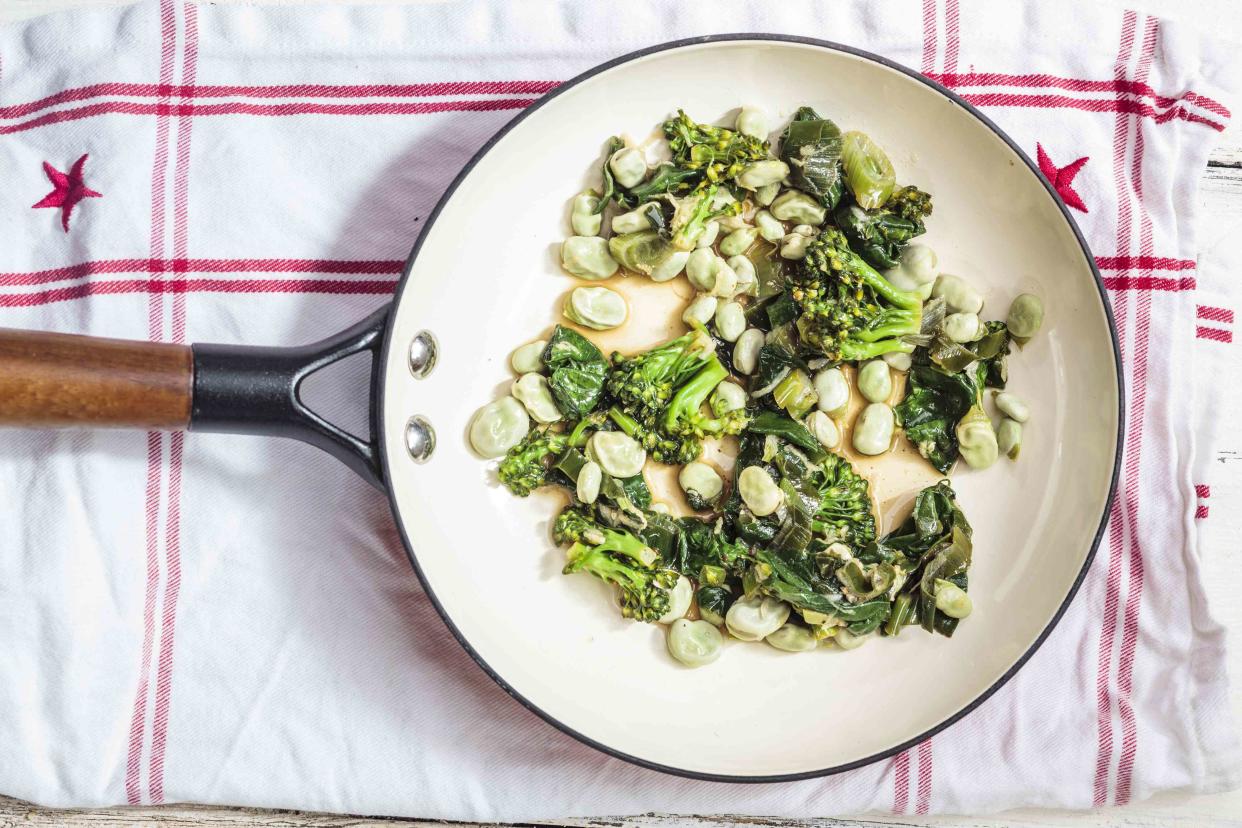How to Sauté Like a Chef
A hot pan and a bit of oil or butter is all you need to have a meal ready in minutes.

Westend61 / Getty Images
If there is any cooking technique you need to know, it’s how to sauté. Sauté means to cook food in a small amount of fat, such as oil or butter, in a hot, shallow pan. The term comes from the French word “sauter,” which means to jump. This makes sense, as when you sauté food, it essentially jumps around in the pan as you flip and stir it with a utensil to ensure even cooking. Sautéeing is a relatively fast cooking technique that allows you to brown food as you cook off excess liquid to intensify the flavor in your food.
What tools do you need to sauté?
If you think of a chef standing in front of a stove tossing food in a pan front to back and up and down as it cooks, that’s food being sautéed. Sautéeing requires just a pan, a wooden spoon or spatula. And, of course, a stove.
Sautéeing most often occurs in a skillet, frying pan, or sauté pan. While skillet and frying pan are generally interchangeable terms referring to a flat, low-sided pan, a sauté pan is best described as a high-sided skillet. A sauté pan has sides that are perpendicular to the bottom of the pan and are straighter and higher than the sides of a frying pan. Sauté pans can hold more volume than a frying pan. They remain on the stove throughout cooking, while a frying pan can be lifted and “tossed” while cooking. A frying pan has lower, more curved sides, allowing for you to flick your wrist and move the food in the pan, thus requiring less stirring or flipping with a spoon.
Related: The 6 Best Frying Pans for Searing, Sautéeing, and Simmering, Based on Our Tests
What are the best foods to sauté?
Ingredients that cook quickly and evenly using an even and consistent heat source are the best to sauté — from vegetables to seafood and meat. The hot pan, along with a minimal amount of butter or oil, transforms an ingredient from raw to cooked by searing the exterior as it heats the interior. As it cooks, water in the ingredient evaporates, creating a more desirable texture and flavor as it browns.
Sautéeing is also the initial step to many soup and stew recipes that call for you to soften or brown your onions, carrots, and celery as the first step, before adding broth and other ingredients. Sautéeing the base vegetables of your soup or stew, versus just dumping them into the liquid to boil, deepens the flavor of the ingredients and creates a more flavorful end product.
How do you sauté?
The two most important things to keep in mind when sautéeing food is the ratio of fat to your ingredient and the size of your ingredient. You’ll need to have enough oil or butter in the pan to facilitate even cooking; however, you don’t want to add so much that you are shallow-frying. As a general rule, sautéeing uses anywhere from one to four tablespoons for a large skillet. Of course, this amount of fat varies if you have a smaller or larger pan, or more or less ingredients. And those ingredients should be cut to an even size so they cook at the same rate.
When you are ready to sauté, heat the oil or butter in a skillet over medium to medium-high heat. Add your ingredients, keeping an eye on the amount of food and the size of your pan.
It’s important you don’t overcrowd the pan with food when sautéeing. The ingredients need enough room to brown — if there is too much food, the ingredients will steam instead of brown. As you cook, be sure to stir them occasionally, to make sure everything is evenly cooked. Stirring while sautéeing means even if there are hot spots in your pans or on your stove, the ingredients will get cooked equally. Cook until they are lightly browned and reach the desired doneness, often anywhere from one to 10 minutes.
How does sautéeing differ from stir-frying and searing?
Similar to sautéeing, stir-frying is another dry heat cooking technique that uses a hot pan with a minimal amount of fat. However, stir-frying is done over high heat whereas sautéeing is done over medium-high or medium heat. Stir-frying is generally associated with Asian cooking and calls for a wok, though you can also use a cast-iron pan in a pinch. Cooking over high-heat simulates a more crisp and browned texture more similar to deep frying while only using minimal oil.
Related: Stir-Fry Recipes
Related: 15 Best Stir-Fry Recipes
Searing involves cooking food in fat in a hot pan until deeply browned on each side. It differs from sautéeing in that the food is not stirred or disturbed except for the one time that it is flipped over to create the same browned texture on the opposite side. Searing generally occurs in a frying pan, skillet, or saute pan over at least medium-high heat, and is most commonly used when cooking meat and fish.
For more Food & Wine news, make sure to sign up for our newsletter!
Read the original article on Food & Wine.






